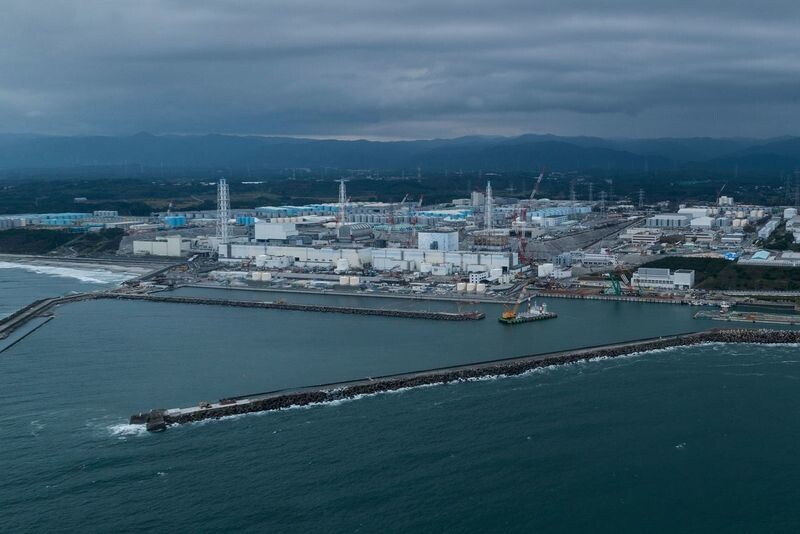hankyoreh
Links to other country sites 다른 나라 사이트 링크
[Column] Fukushima’s contaminated water is an issue affecting all of humanity

As the possibility of Japan dumping contaminated water from the Fukushima Nuclear Power Plant into the ocean has been raised, concerns are being voiced on the Korean Peninsula and through various international organizations. Obviously, it is South Korea that is leading the efforts at international coordination in organizations like the International Atomic Energy Agency (IAEA), International Maritime Organization (IMO), and World Health Organization (WHO).
The biggest issue that stands to arise if the contaminated water is dumped into the ocean is the major impact on the marine environment in the Western Pacific and the health of residents in the region, and South Korea is the closest neighbor to Japan.
In a recent piece published in the UK’s The Economist, Shaun Burnie of Greenpeace Germany warned that if Japan dumped the water into the pacific, radioactive material will begin flowing into the East Sea within a year. As Japan’s closest neighbor, South Korea has maintained that it has a right to sufficiently discuss the potential environmental threat and demand related information. During a South Korean parliamentary audit, expressions of concern about the Fukushima water release were coupled with demands for response measures to be put in place.
Unfortunately, these messages and warnings are not being expressed as part of a system of guidance and cooperation to permit a fundamental resolution. Rather, they amount more to a form of pressure within international discourse, which runs the risk of being shrugged off with pro forma logic. The predictions that radioactive material will begin washing into the East Sea within a year could change with the actual amounts and concentrations of water dumped; in the absence of real announced concentrations of inflowing contaminants, it does nothing more than to raise a threat.
More than the fact of the inflows over the year after release, we need to be aware that there are migrating species that could enter the waters near South Korea at any time. Also, what is to be done about the destruction to the marine ecosystem or the marine life that is being fished in the Pacific by the different countries? The result would be a disaster for humankind. We need a more in-depth and scientific examination to identify a disposal plan that allays the concerns of Japan’s neighbors as well as those of Japanese civil society and fishers, who are the ones suffering the ill effects first hand.
Plans for handling marine contaminants fall into five main categories. The first involves controlling the source. The most basic means of resolution is to replace materials and production processes and ban production and consumption to ensure that contaminants are not released in the first place. The second involves recirculation and reuse. This means either re-circulating contaminants through nature or reusing them for other purposes. The third involves storing the contaminants. In cases where no disposal method has yet been developed and reuse is not an option, the approach has been to contain and process them at a safe distance from areas of human activity.
The fourth involves controlling contamination through a regional quota system. This means applying different standards for management depending on the uses of particular waters; in South Korea’s case, marine protected areas and special management areas fall into this category. The last approach is contamination control through taxation. Under such a system, penalties are imposed in cases where contamination is unavoidable; as a rule, the party responsible bears the costs for compensation and restoration.

An ocean dump from a nuclear power plant at the current level, without any international regulations in place, would be utterly unacceptable and an affront to environmental justice for humanity today and future generations. Radioactive material decays naturally; if set apart and stored, it goes away naturally over time. But because of issues concerning time and space, this is not an economical approach, and new and effective disposal technology could be developed while it is being stored.
This is why the nuclear power plant water issue is something that should be approached as an issue affecting all of humanity, rather than one restricted to Fukushima and Japan. In particular, neighbors and countries possessing nuclear power plants of their own should make it a priority to cooperate fully in technological and economic terms.
Human disasters may start in one country, but it is through international cooperation that a country’s disaster can be resolved.
By Lee Suk-mo, professor of ecological engineering at Pukyong National University
Please direct comments or questions to [english@hani.co.kr]

Editorial・opinion
![[Column] Park Geun-hye déjà vu in Yoon Suk-yeol [Column] Park Geun-hye déjà vu in Yoon Suk-yeol](https://flexible.img.hani.co.kr/flexible/normal/500/300/imgdb/original/2024/0424/651713945113788.jpg) [Column] Park Geun-hye déjà vu in Yoon Suk-yeol
[Column] Park Geun-hye déjà vu in Yoon Suk-yeol![[Editorial] New weight of N. Korea’s nuclear threats makes dialogue all the more urgent [Editorial] New weight of N. Korea’s nuclear threats makes dialogue all the more urgent](https://flexible.img.hani.co.kr/flexible/normal/500/300/imgdb/original/2024/0424/7317139454662664.jpg) [Editorial] New weight of N. Korea’s nuclear threats makes dialogue all the more urgent
[Editorial] New weight of N. Korea’s nuclear threats makes dialogue all the more urgent- [Guest essay] The real reason Korea’s new right wants to dub Rhee a founding father
- [Column] ‘Choson’: Is it time we start referring to N. Korea in its own terms?
- [Editorial] Japan’s rewriting of history with Korea has gone too far
- [Column] The president’s questionable capacity for dialogue
- [Column] Are chaebol firms just pizza pies for families to divvy up as they please?
- [Column] Has Korea, too, crossed the Rubicon on China?
- [Correspondent’s column] In Japan’s alliance with US, echoes of its past alliances with UK
- [Editorial] Does Yoon think the Korean public is wrong?
Most viewed articles
- 1[Column] Park Geun-hye déjà vu in Yoon Suk-yeol
- 2Thursday to mark start of resignations by senior doctors amid standoff with government
- 3Kim Jong-un expressed ‘satisfaction’ with nuclear counterstrike drill directed at South
- 4[Column] ‘Choson’: Is it time we start referring to N. Korea in its own terms?
- 5N. Korean hackers breached 10 defense contractors in South for months, police say
- 6Will NewJeans end up collateral damage in internal feud at K-pop juggernaut Hybe?
- 7Why Korea shouldn’t welcome Japan’s newly beefed up defense cooperation with US
- 8[Editorial] New weight of N. Korea’s nuclear threats makes dialogue all the more urgent
- 9[Guest essay] The real reason Korea’s new right wants to dub Rhee a founding father
- 10[Column] Yoon’s first 100 days should open our eyes to pitfalls of presidential system